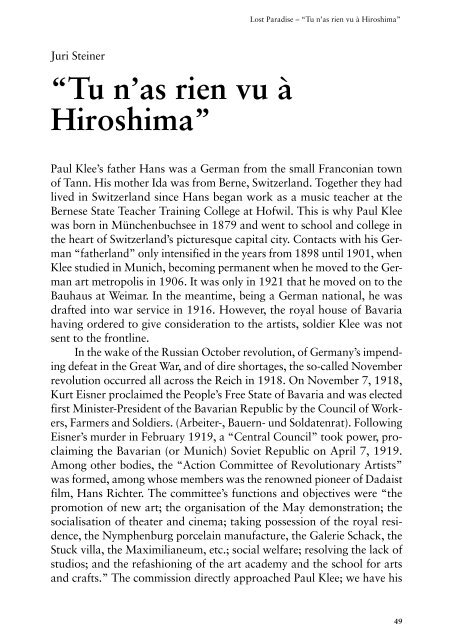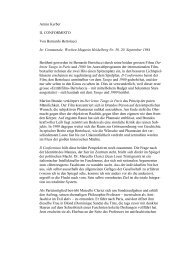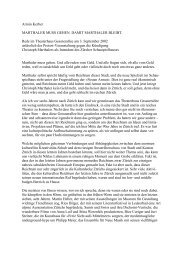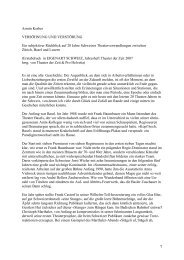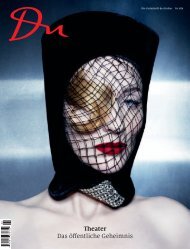You also want an ePaper? Increase the reach of your titles
YUMPU automatically turns print PDFs into web optimized ePapers that Google loves.
Juri Steiner<br />
“Tu n’as rien vu à<br />
Hiroshima”<br />
<strong>Lost</strong> <strong>Paradise</strong> – “Tu n’as rien vu à Hiroshima”<br />
Paul Klee’s father Hans was a German from the small Franconian town<br />
of Tann. His mother Ida was from Berne, Switzerland. Together they had<br />
lived in Switzerland since Hans began work as a music teacher at the<br />
Bernese State Teacher Training College at Hofwil. This is why Paul Klee<br />
was born in Münchenbuchsee in 1879 and went to school and college in<br />
the heart of Switzerland’s picturesque capital city. Contacts with his German<br />
“fatherland” only intensified in the years from 1898 until 1901, when<br />
Klee studied in Munich, becoming permanent when he moved to the German<br />
art metropolis in 1906. It was only in 1921 that he moved on to the<br />
Bauhaus at Weimar. In the meantime, being a German national, he was<br />
drafted into war service in 1916. However, the royal house of Bavaria<br />
having ordered to give consideration to the artists, soldier Klee was not<br />
sent to the frontline.<br />
In the wake of the Russian October revolution, of Germany’s impending<br />
defeat in the Great War, and of dire shortages, the so-called November<br />
revolution occurred all across the Reich in 1918. On November 7, 1918,<br />
Kurt Eisner proclaimed the People’s Free State of Bavaria and was elected<br />
first Minister-President of the Bavarian Republic by the Council of Workers,<br />
Farmers and Soldiers. (Arbeiter-, Bauern- und Soldatenrat). Following<br />
Eisner’s murder in February 1919, a “Central Council” took power, proclaiming<br />
the Bavarian (or Munich) Soviet Republic on April 7, 1919.<br />
Among other bodies, the “Action Committee of Revolutionary Artists”<br />
was formed, among whose members was the renowned pioneer of Dadaist<br />
film, Hans Richter. The committee’s functions and objectives were “the<br />
promotion of new art; the organisation of the May demonstration; the<br />
socialisation of theater and cinema; taking possession of the royal residence,<br />
the Nymphenburg porcelain manufacture, the Galerie Schack, the<br />
Stuck villa, the Maximilianeum, etc.; social welfare; resolving the lack of<br />
studios; and the refashioning of the art academy and the school for arts<br />
and crafts.” The commission directly approached Paul Klee; we have his<br />
49


